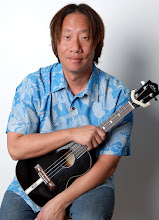Summer is definitely getting into high gear - I can tell from all the fun party and wedding events I've been playing for! This past weekend I was hired for another summer wedding event - this time, ukulele-only music was requested for the ceremony. The bride was actually someone I met through the new ukulele class I started on Mondays at the South Bay Adult School and she had some special requests like my What A Wonderful World for the bridesmaids, Pua Lililehua for the Processional, and since the groom's parents are from England, my arrangement of Here Comes The Sun for the Recessional. You know, given his love for the instrument, I wouldn't be surprised to learn that George Harrison wrote the song on an ukulele. Here's a fun video of George with his uke, hanging with Ringo and Sir Paul.
Got a few more ukulele weddings happening this summer so I'll have a chance to whip out some new arrangements of I'm Yours, Summertime, Sway, Top Of The World and some other fun stuff I've been working on.
Tuesday, August 24, 2010
Thursday, August 19, 2010
Intro To Playing Ukulele Scales
 You don't want to always be only strumming chords do you? It's fun playing the melody to your favorite songs and here's an easy way to get started.
You don't want to always be only strumming chords do you? It's fun playing the melody to your favorite songs and here's an easy way to get started.Up/Down
Lots of people who've been playing 10+ years still don't know the proper "up" and "down" so we need to clarify this right now:
Put your finger on the fifth fret of any string. There should be a fret marker dot there. Now move that finger to the sixth fret of the same string. The sound went "up" therefore this is what we call "up". Always think of the sound, not which way your fingers/ hands are physically moving. Moving from fret to fret is also known as a half step. From the fifth fret to the tenth, your finger
moved UP five frets/half steps or two whole steps and one half step. Simple enough, no?
The Major Scale
I assume you're already familiar with this: Do Re Mi Fa So La Ti Do. Eight notes and a song/sound we are all very familiar with. This is the sound of a major scale and there is a formula behind the series of notes that gives it its familiar sound.
Basically, any scale is simply a given series of whole step and half step movements (whole = 2 frets, half = 1 fret). For a major scale it is: Root - W - W - H - W - W - W - H.
Here's how it works: Choose the 3rd string open as a starting point. This is the C string therefore our first note is C, otherwise known as the "root".
From this open string, play the note on the 2nd fret which is a whole step (2 frets) UP.
Then move up another whole step (2 frets), then a HALF step (1 fret), a whole step (2 frets), a whole step (2 frets), a whole step (2 frets), then finally a half step (1 fret) for a total of eight notes.
You just played the C major scale!
Frets played = 0, 2, 4, 5, 7, 9, 11, 12.
Notes played = C, D, E, F, G, A, B, C
It doesn't matter what your starting point is. As long as you apply the same formula and there are enough frets on your uke to play all eight notes, you can play any scale (any key) you want.
Is it a little cumbersome to try to play a whole scale on one string? Yes. That's why there's more than just one string on the ukulele. Watch this video to learn how to play the C scale across three strings instead of just one.
It's a damn good lesson! I also talk about articulation and how to figure out melodies so check it out!
Subscribe to:
Comments (Atom)

